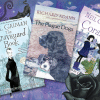Ludic space for Tagore’s fictive children

An interesting concern in contemporary children's literature criticism is the discussion of power. Do the fictive children in children's books, conceived and delivered by the adult author, have the ability to exercise their will and possess a voice? There are several possibilities here. The fictive children protagonists are articulated in realist narratives where subjective and collective truths are voiced. Another possibility is the imagined worlds of children are an aesthetic space where a restorative re-imagining and re-inventing takes place as the nostalgic author paints a picture of childhood. A third possibility is that the reader visits and explores defamiliarisingly innovative and fantastic worlds of fictive children and is wondered by the transformative experience. In this short piece, I examine Tagore's fictive children and their ludic space in a bid to uncover their different forms of engagements. I do this via some exemplary pieces from Tagore's collections The Crescent Moon (Macmillan and Company, 1924) and Shishu (first published 2008).
Tagore's own childhood experiences have important bearings on the consciousness of his fictive children (Chaudhury, 2013). The 'nostalgia' of his 'lost childhood' is noticeable in Tagore's portrayal of nature as a protective and formative force juxtaposed with the image of a loving mother - both of whom offer infinite worlds of bounty, pleasure and opportunity and nurture the child with care and sensitivity.
Ludic space in the context of children's literature is the environment—poetic or narrative—designed for play, exploration, and imaginative engagement. The term 'ludic' is derived from the Latin word 'ludus', which means play. For the author in children's literature, creating ludic spaces is often intentional, aiming to encourage creativity, curiosity, and a sense of awe and wonder in readers. The ludic space for Tagore's fictive children is often 'nature', as opposed to the constraints of home. Immersed in a seemingly infinite world of pleasure and opportunity, his fictive children "shout and dance, build houses with sand, play with empty shells, weave boats with leaves and float them on the vast deep" ("On the Seashore"). In "Playthings", the child protagonist plays to his utter satisfaction with "twigs, sticks and mud pies" while the adult observer, the first-person narrator of the poem, "struggles to cross the sea of desire", plays with "costly playthings", gathers only "lumps of gold and silver", and gains no inner peace. The adult observer (and the authorial voice) continues to build a series of exaggerated dichotomies between adult-oriented and child-oriented perspectives in other poems. For instance, in "The Last Bargain", the adult (author) goes through a transformational experience as he observes and communicates with the child:
A child sat playing with shells.
He raised his head and seemed to know me,
and said, 'I hire you with nothing.'
From thenceforward that bargain struck
in child's play made me a free man.
The fictive child exercises more power in "Paper Boats" where he (used generically) launches paper boats down a running stream in a symbolic dream sequence, joined by the nature as an unknown empathetic friend, who, he is sure, would make the "paper boats float on and on under the midnight stars." The child protagonist continues to enjoy the autonomy of experiencing an adventure in "The Sailor" where he dreams of "sail[ing] merrily across the seven seas and the thirteen rivers of fairyland" with his friend and says, "I shall never steer [the boat] to stupid markets"—a reference to the real-life adult world. Even when he imagines he is travelling into strange lands as a merchant, he does not want to hoard gold—a reference to the materialistic gains of the adult world. He promises to bring home baskets full of "champa flowers" for mother, "a pair of horses with wings" for brother, and for father, "a magic pen that, without his knowledge, will write of itself" ("The Merchant"). The fictive child looks at the 'serious' adult world of work through the lens of play, and as a chance to assert his own will and agency. For instance, in "Vocation", he wishes to be a hawker who unhurriedly sells crystal bangles, a gardener "digging the ground" without interruption, or a "watchman", "walking the streets all night chasing shadows with his lantern." In "The Future Bank", he wants to be a boatman, so that he could sail across the river to enjoy the simplicity and beauty of rural life. Inspired by the child-play, the adult observer wishes to revert to his childhood: "I wish I could take a quiet corner in the heart of my baby's very own world" ("Baby's World"). Thus, within the ludic space, the child teaches the adult a vision of moral well-being, and at the same time, sends a meta-communicative message to the readers about the transformative potential of child-play.
Scholars of the history of childhood contend that children embody a state of innocence, purity and natural goodness which is only contaminated when in contact with the corrupt adult world. This idealised version of childhood and the Romantic discourse, via the hands of poets such as William Blake and William Wordsworth, became enormously influential throughout the 19th and into the 20th century (Hunt, 1991). The first generation of Bengali writers, who came before Tagore, popularised a moralist account of the child as inherently sinful, and in need of moral and intellectual training in reason (N. Sen, 2015). Countering 'the demonic child', the Romantic-inspired Tagore and his contemporaries sought to re-write the fictive child as naturally good, possessed of its own special kind of genius. The child as pure, fresh and free is noticeable in Tagore's description of the physical attributes of the child archetype. For instance, in the smile on the child's lips, the adult author, from the point of view of the mother, discovers the glow of "a young pale beam of a crescent moon touched the edge of a vanishing autumn cloud" and freshness of "the dream of a dew washed morning." In the sleep in the child's eyes, the adult sees "shy buds of enchantment" "in the fairy village among shadows of the forest dimly lit with glow-worms"; and in "the sweet, soft freshness" of his limbs, the adult author finds traces of the "tender and silent" "mystery of love" hidden in the mother's heart when "she was a young girl" ("The Source"). Nature's gaiety and spontaneity are reflected in the child's movements as in "Clouds and Waves", where he rolls like waves on the shore of his mother's lap free of care: "I will be the waves and you will be a strange shore / I shall roll on and on and on, and break upon your lap with laughter", and in "The Flower School", where the children are blossoming flowers: "When the rain comes…the flower children rush out in dresses of pink and yellow and white." The fictive child's indomitable joie de vivre is an empowerment of the child, sanctioned whole-heartedly by the implied and approving adult author.
Tagore's own childhood experiences have important bearings on the consciousness of his fictive children (Chaudhury, 2013). The 'nostalgia' of his 'lost childhood' is noticeable in Tagore's portrayal of nature as a protective and formative force juxtaposed with the image of a loving mother—both of whom offer infinite worlds of bounty, pleasure and opportunity and nurture the child with care and sensitivity. In "The Beginning", the fictive child, curious about his origin, mischievously asks the mother: "'Where have I come from, where did you pick me up?'", and "(s)he answered half crying, half laughing, and clasping the baby to her breast, 'You were hidden in my heart as its desire, my darling'." The mother (representing the adult author) further explains in "The End" that the child is the essence of her girlhood and lives "in the pupils of mother's eyes, in her body and soul" ("The End"). In "Sleep-Stealer", the mother is concerned about her child's sleep, making her angry after the fairy thief who "stole sleep from baby's eyes" in her absence. She vows to punish the fairy by "raiding her nest…where she hoards all her stolen sleep."
The ludic space–various forms of imaginary play and its setting, and the joyful romantic disposition are used as a trope in Tagore to manifest child agency. The ever-presence of the bewildered adult author-observer indicates that he (generically) is searching for a 'lost' childhood—a deeper, pre-rational past that is only accessible to children. The fictive child, in this sense, is both an Other and a Self (Stephens, 1992) to the adult author. While the child's romantic imagination differentiates him from the adult, he also functions as a mirror of the adult's nostalgic childhood and a screen on which he can project his romantic inclinations. Behind its disguise of playful frivolity, the fictive child is the adult author's vehicle to rediscover the inner worlds of childhood and its freedom, and to connect it to the outer world of the present.
Sabrina S Kamal has a PhD in Education from University of Cambridge and currently works with a consortium of local schools in Cambridge, UK.

 For all latest news, follow The Daily Star's Google News channel.
For all latest news, follow The Daily Star's Google News channel. 








Comments